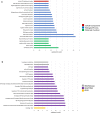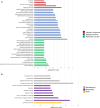Early onset senescence and cognitive impairment in a murine model of repeated mTBI
- PMID: 33964983
- PMCID: PMC8106230
- DOI: 10.1186/s40478-021-01190-x
Early onset senescence and cognitive impairment in a murine model of repeated mTBI
Abstract
Mild traumatic brain injury (mTBI) results in broad neurological symptoms and an increased risk of being diagnosed with a neurodegenerative disease later in life. While the immediate oxidative stress response and post-mortem pathology of the injured brain has been well studied, it remains unclear how early pathogenic changes may drive persistent symptoms and confer susceptibility to neurodegeneration. In this study we have used a mouse model of repeated mTBI (rmTBI) to identify early gene expression changes at 24 h or 7 days post-injury (7 dpi). At 24 h post-injury, gene expression of rmTBI mice shows activation of the DNA damage response (DDR) towards double strand DNA breaks, altered calcium and cell-cell signalling, and inhibition of cell death pathways. By 7 dpi, rmTBI mice had a gene expression signature consistent with induction of cellular senescence, activation of neurodegenerative processes, and inhibition of the DDR. At both timepoints gliosis, microgliosis, and axonal damage were evident in the absence of any gross lesion, and by 7 dpi rmTBI also mice had elevated levels of IL1β, p21, 53BP1, DNA2, and p53, supportive of DNA damage-induced cellular senescence. These gene expression changes reflect establishment of processes usually linked to brain aging and suggests that cellular senescence occurs early and most likely prior to the accumulation of toxic proteins. These molecular changes were accompanied by spatial learning and memory deficits in the Morris water maze. To conclude, we have identified DNA damage-induced cellular senescence as a repercussion of repeated mild traumatic brain injury which correlates with cognitive impairment. Pathways involved in senescence may represent viable treatment targets of post-concussive syndrome. Senescence has been proposed to promote neurodegeneration and appears as an effective target to prevent long-term complications of mTBI, such as chronic traumatic encephalopathy and other related neurodegenerative pathologies.
Keywords: Ageing; Concussion; DNA damage response; Neurodegeneration; Neuroinflammation; Senescence; Traumatic brain injury.
Conflict of interest statement
The authors declare that they have no competing interests.
Figures
















Similar articles
-
Cellular Senescence in Traumatic Brain Injury: Evidence and Perspectives.Front Aging Neurosci. 2021 Sep 28;13:742632. doi: 10.3389/fnagi.2021.742632. eCollection 2021. Front Aging Neurosci. 2021. PMID: 34650425 Free PMC article. Review.
-
DNA repair deficiency and senescence in concussed professional athletes involved in contact sports.Acta Neuropathol Commun. 2019 Nov 14;7(1):182. doi: 10.1186/s40478-019-0822-3. Acta Neuropathol Commun. 2019. PMID: 31727161 Free PMC article.
-
CHIMERA repetitive mild traumatic brain injury induces chronic behavioural and neuropathological phenotypes in wild-type and APP/PS1 mice.Alzheimers Res Ther. 2019 Jan 12;11(1):6. doi: 10.1186/s13195-018-0461-0. Alzheimers Res Ther. 2019. PMID: 30636629 Free PMC article.
-
Chronic gliosis and behavioral deficits in mice following repetitive mild traumatic brain injury.J Neurosurg. 2014 Dec;121(6):1342-50. doi: 10.3171/2014.7.JNS14272. Epub 2014 Sep 30. J Neurosurg. 2014. PMID: 25267088 Free PMC article.
-
Repeated Mild Traumatic Brain Injury: Potential Mechanisms of Damage.Cell Transplant. 2017 Jul;26(7):1131-1155. doi: 10.1177/0963689717714092. Cell Transplant. 2017. PMID: 28933213 Free PMC article. Review.
Cited by
-
Reactive gliosis in traumatic brain injury: a comprehensive review.Front Cell Neurosci. 2024 Feb 28;18:1335849. doi: 10.3389/fncel.2024.1335849. eCollection 2024. Front Cell Neurosci. 2024. PMID: 38481632 Free PMC article. Review.
-
Functional and transcriptional profiling of microglial activation during the chronic phase of TBI identifies an age-related driver of poor outcome in old mice.Geroscience. 2022 Jun;44(3):1407-1440. doi: 10.1007/s11357-022-00562-y. Epub 2022 Apr 22. Geroscience. 2022. PMID: 35451674 Free PMC article.
-
Cellular senescence in brain aging and cognitive decline.Front Aging Neurosci. 2023 Nov 23;15:1281581. doi: 10.3389/fnagi.2023.1281581. eCollection 2023. Front Aging Neurosci. 2023. PMID: 38076538 Free PMC article. Review.
-
Cellular Senescence in Traumatic Brain Injury: Evidence and Perspectives.Front Aging Neurosci. 2021 Sep 28;13:742632. doi: 10.3389/fnagi.2021.742632. eCollection 2021. Front Aging Neurosci. 2021. PMID: 34650425 Free PMC article. Review.
-
A geroscience motivated approach to treat Alzheimer's disease: Senolytics move to clinical trials.Mech Ageing Dev. 2021 Dec;200:111589. doi: 10.1016/j.mad.2021.111589. Epub 2021 Oct 21. Mech Ageing Dev. 2021. PMID: 34687726 Free PMC article. Review.
References
Publication types
MeSH terms
Grants and funding
LinkOut - more resources
Full Text Sources
Other Literature Sources
Medical
Research Materials
Miscellaneous

